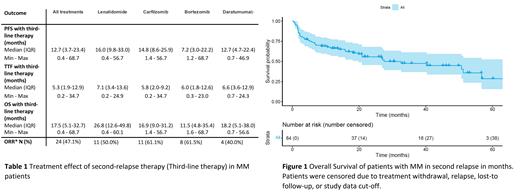Introduction:
The incidence of multiple myeloma (MM) has been increasing globally (Institute for Health Metrics and Evaluation ; Cancer Research UK 2021), particularly in high-income countries (Ferlay J et al. (2020); Cowan et al. 2018). However, low-income countries, including Colombia, have also experienced a progressive increase in new cases (Fondo Colombiano de Enfermedades de Alto Costo. Cuenta de Alto Costo (CAC) ; Martínez Cordero et al. 2020). In the context of MM, the duration of progression free survival decreases after each relapse rendering as highly important the election of and adequate treatment (Yong et al. 2016), yet there is a lack of local data on patients experiencing a second relapse in Colombia to guide these decisions. This study aims to characterize Colombian patients with MM in second relapse, the current treatment patterns, and assess clinical response to address this knowledge gap.
Methods:
An observational retrospective study was conducted, utilizing chart review data from five specialized cancer treatment institutions in Colombia. Adult MM patients with diagnosed second relapse between January 1, 2013 and June 30, 2021 who had received at least two prior lines of treatment including lenalidomide and a proteasome inhibitor were included. Patients receiving only palliative care were excluded. Data on the effectiveness and safety of treatment patterns were collected from the start of the second relapse treatment pattern until the occurrence of treatment withdrawal, death, initiation of treatment pattern for third relapse diagnosed, loss of follow-up or study cutoff date (June 30, 2022), whichever happened earlier. The main outcomes were progression free survival (PFS), time to treatment failure (TTF), overall survival (OS), and overall response rate (ORR). All variables were analyzed descriptively utilizing appropriate statistics measures such as, means or medians, with corresponding standard deviation or interquartile range for continuous variables, and frequencies and percentages for categorical variables. OS was determined using the Kaplan-Meier method.
Results:
A total of 84 Patients were included from 5 centers in 3 of the Colombian regions (Andean, Pacific and Caribbean), 47 (56%) were male. The mean age at the time of MM diagnosis was 62.3 (SD 11.7) years. On average, the time from initial diagnosis to the occurrence of the second relapse was 3.6 (SD 2.1, min: 0.6 max: 11.2) years. The most frequent type of relapse observed was biochemical relapse, accounting for 42 cases (51%). Immunoglobulin levels were used as biomarkers, with IgA M-protein (g/dL) measuring 0.7 (SD 2.8, min:0 max: 16.2) and IgG M-protein (g/dL) measuring 31.8 (SD 185.4, min 0, max: 1,144.3). Furthermore, 41 patients (49%) exhibited bone lesion as a sign of second relapse.
The most frequent treatments received for second relapse included lenalidomide 33 (14.7%), carfilzomib 29 (12.9%), bortezomib 23 (10.3%) and daratumumab 22 (9.8%). Among the patients who received lenalidomide, 87.9% had received bortezomib as first-line therapy, while 18.2% leniladomide. Conversely, 75.8% had received lenalidomide as second-line therapy, and 45.5% bortezomib.
Table 1 displays the main outcomes according to the treatment received. Regardless of the treatment, the average PFS was 12.7 (IQR 3.7-23.4) months, the TTF was 5.3 (IQR 1.9-12.9) months, and the ORR was 47.1%. Figure 1 illustrates the OS, revealing that at 27.5 months 50% of the study population had either died (21, 25%) or been censored (21, 25%).
Treatment-emergent adverse events (TEAE) were reported in 10 patients (11.9%). The most frequent TEAE were anemia and neutropenia, reported in 2 patients.
At the end of study cut off 21 patients (25%) had died, 8 (9.5%) had discontinued treatment, 42 (50%) had a third relapse, 4(4.8%) were lost to follow-up, 9 (10.7%) were still undergoing treatment.
Conclusions:
The FreedoMM study is the first to our knowledge, to describe comprehensively the characteristics, treatment patterns, and clinical response of Colombian patients experiencing a second relapse of MM. The study highlights the poor outcomes observed in this specific population. Indeed, the study underscore the clear necessity for additional research and the development of treatment guidelines tailored specifically to patients in their second of MM in Colombia and other similar countries.
Disclosures
Quintero:Sanofi: Research Funding. Aruachan:Sanofi: Research Funding. Figueroa Emiliani:Sanofi: Research Funding. Galvez:Sanofi: Research Funding; Boehringer Ingelheim: Honoraria; AbbVie: Other: investigator on AbbVie-sponsored clinical trials. Diaz:Sanofi: Research Funding. Buitrago:Sanofi: Research Funding. Martinez-Cordero:Sanofi: Research Funding. Saavedra:Sanofi: Current Employment.


